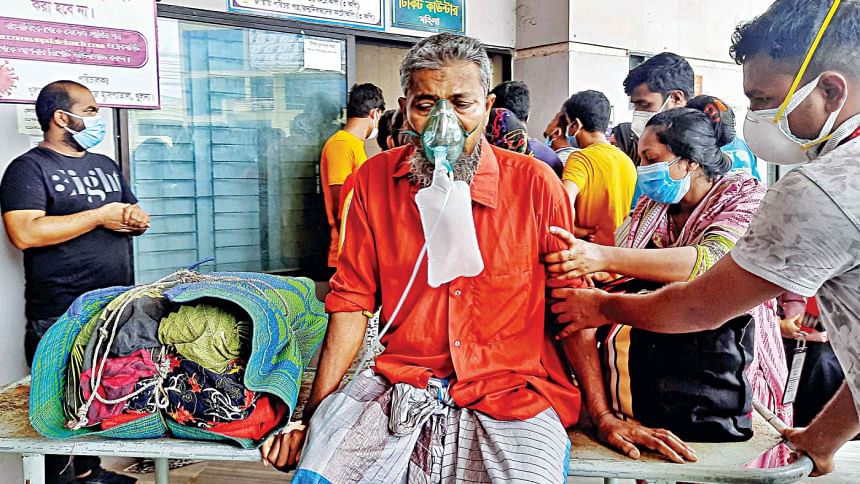Border Hospitals Tackling Covid: Understaffed, under stress

As the Covid-19 crisis continues to unfold in border districts, with some put under lockdown to slow down transmission, major hospitals in those districts totter due to a shortage of frontline doctors and nurses.
Those understaffed hospitals have been grappling with an increased number of coronavirus patients for the past several days.
Take Natore district hospital for an example.
The 50-bed Covid unit at the hospital was struggling to tackle the rush of patients yesterday with five doctors and 10 nurses. Two days earlier, there were only three doctors and three nurses there. Two doctors and seven nurses were brought in as the flow of patients went up significantly.

Those 15 healthcare professionals, however, will be split into two groups. One group will work for 14 days at a stretch while the other group will be in quarantine for that period. That leaves the Covid unit with only seven to eight healthcare professionals at any given day.
That's not the whole story. Those professionals will work in three eight-hour shifts -- morning, evening and night.
This is for a hospital where 88 percent of its Covid beds were filled as of yesterday morning.
The positivity rate in the district was 34 percent as of Sunday, shows data from the Director General of Health Services (DGHS).
"We are managing but if the situation gets worse, I don't know what to do. We are sending one or two critical patients to Bogura every day. Earlier, we used to send them to Rajshahi, but there are no empty beds there anymore," said Dr Poritosh Kumar Roy of the Natore hospital, which has zero ICU beds for Covid patients.
Rajshahi Medical College Hospital too is struggling with an increasing number of coronavirus patients. It is almost 42km away from Natore, making it hard for many critical patients from the district to reach there on time.
The manpower crisis in RMCH is not as acute as in the Natore hospital, said officials there.
There are three hospitals in Bogura where Covid patients can turn to. Of them, the 100-bed Mohammad Ali District Hospital and the Shaheed Ziaur Rahman Medical College Hospital are better equipped in terms of manpower, but TMSS Medical College & Rafatullah Community Hospital lags behind.
Fifty-three out of the 56 Covid beds at the Kushtia Sadar Hospital were filled as of yesterday morning, meaning it was almost at full capacity. The district's positivity rate two days ago was 30 percent.
But this hospital only has 11 doctors and 22 nurses. Once again, duty roster divides this batch up into half, and they then are further spread out over three shifts.
"We are having some trouble because of the roster. We will get more doctors and nurses. We need five doctors on an emergency basis and 50 nurses. All 11 of the doctors here are medical officers," said Dr Taposh Sarkar, the resident medical officer of the hospital.
The hospital's administration said about a quarter of the personnel's posts in the hospital remain vacant.
A little over an hour away, Chuadanga district hospital's 150 Covid-19 beds are under the care of 18 doctors and 65 nurses.
"When the 150-bed hospital was inaugurated, we were not given the healthcare staffers needed to operate this. We are maintaining a roster system for our existing staffers, and encouraging patients to recuperate at home," said Dr Maruf Hasan, civil surgeon general and superintendent of the hospital.
The daily positivity rate in the district was 50 percent on Sunday. It was 56 percent the day before, shows DHGS data.
In neighbouring Meherpur, the 250-bed district hospital has an appalling 5 doctors for 52 Covid-19 beds. The district has an equally appalling positivity rate of 39 percent, making it a high-risk zone.
"I got two more doctors on a temporary basis, but I urgently need at least four more," said Dr Rafiqul Islam, the superintendent of the hospital. "We have to divide the doctors into two batches and send one group to quarantine for 15 days."
According to the Directorate General of Health Services' Covid-19 Dynamic Facility Dashboard, an equally frightening situation can be perceived down south in Narail.
The Narail district hospital has set aside 120 beds for Covid patients, but has only nine doctors, said hospital sources.
When asked to confirm the number, Nasima, the civil surgeon, asked to contact the superintendent of the hospital Dr Abdus Shakur.
Shakur, however, said he could not verify the number until the next morning.
This district has a daily positivity rate as high as 44 percent.
Moving to the west, the Jashore 250-bed general hospital was at 91 percent capacity yesterday with 41 of its 45 Covid-19 beds occupied, but this hospital has only 12 doctors and 10 nurses to deal with the influx of patients, said Civil Surgeon Sheikh Abu Shaheen.
But this is a crucial district where the daily positivity rate yesterday stood at 56 percent.
As a result, all patients in the southern division flock to Khulna Medical College and Hospital.
The hospital with a 100 Covid-19 dedicated beds was overflowing. It was being taken care of by 34 doctors.
Rabiul Hasan, the hospital's director, reports that beds or no beds, patients are now being accommodated anyway. "We have 141 Covid-19 patients admitted in the hospital right now," he said.
He said they do not have any shortage of healthcare professionals.

Khulna's positivity rate stood at 25 percent yesterday. Neighbouring Bagerhat's positivity rate was 26 percent, and its Mongla upazila is on lockdown, but its sole district hospital suffers acutely from a manpower shortage.
There are 53 Covid-19 dedicated beds in the Bagerhat district hospital, of which 40 percent were filled, but the hospital is staring down the barrel of a looming healthcare crisis with only 22 doctors.
Our correspondent reports that roster duty means there are just not enough doctors to tackle the crisis and that a newly built 150-bed hospital lies empty for that reason.
Infectious diseases specialist Ridwanur Rahman commented that there was a huge geographical disparity in the distribution of healthcare staffers.
"There is a geographical disparity regarding which districts have more manpower. There is no policy -- if a doctor gets sent to an outpost, he or she needs to lobby to get transferred, so doctors are unwilling to receive transfers to other districts," said Ridwanur.
"There was no planning when it came to the growth of manpower in the healthcare sector. They are more focused on medical supply purchase rather than investing in the manpower, and now service provision has become difficult," he added.
Contacted, DGHS Director (hospitals) Farid Hossain, said, "We have collected lists of posts, which are vacant in hospitals. We are taking steps to recruit an adequate number of manpower. It is up to the higher authorities to decide how quickly those vacant posts will be filled."
[Our Benapole correspondent Mohsin Milon contributed to this report]


 For all latest news, follow The Daily Star's Google News channel.
For all latest news, follow The Daily Star's Google News channel. 



Comments